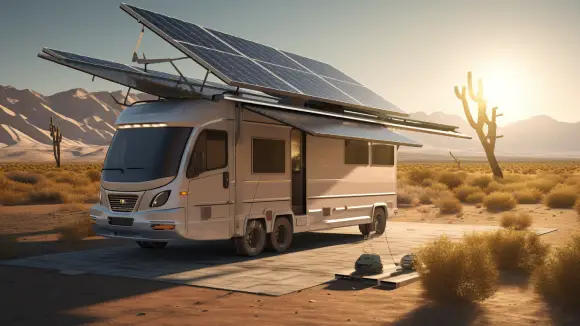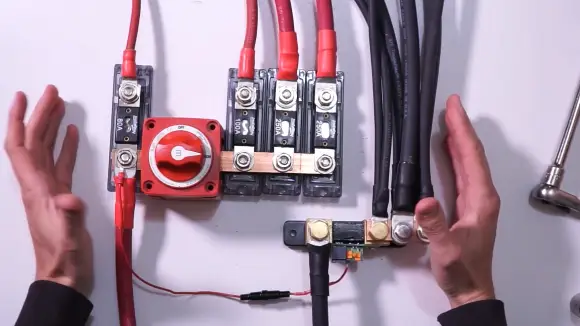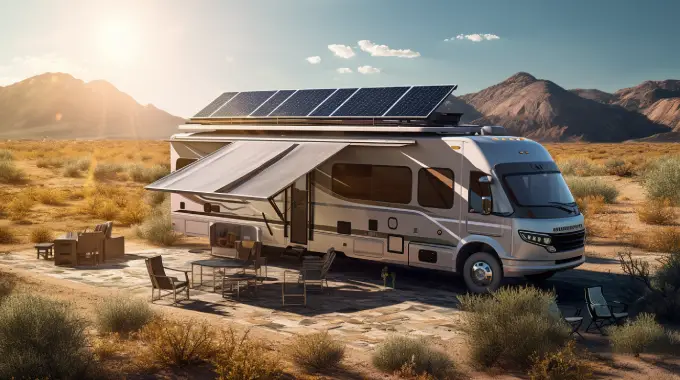When you hear the term “Solar Ready,” you might think your RV is ready to start using solar power immediately. However, that’s not the actual term. When an RV is ‘Solar Ready,’ it means it is equipped with a solar connection port, but you must purchase the necessary components at your own expense.
This term is often misunderstood, as it does not imply that the RV has all the components needed for solar power. Instead, it simply means that the RV has been wired for solar power and has a designated port for connecting the solar system.
This article discusses the equipment you’ll need, whether you must buy from the manufacturer, and how many panels it takes to run your rolling home. Continue reading to discover solar energy’s potential.
What Does It Mean When an RV Is Solar Ready: Need 4 Equipment

When setting up a full RV solar power system, there are several key components that you’ll need to consider.
- Solar panels
- A charge controller
- A sufficient battery bank
- Proper wiring
Let’s discuss about these RV solar power components in detail:
1. Solar panels
Solar panels are the most crucial component of any RV solar power system. They are responsible for absorbing the sun’s energy and converting it into DC electricity, which can power all your electrical devices on the go.
Typically, RV solar systems employ polycrystalline or monocrystalline solar panels, depending on the budget and power requirements. Polycrystalline panels are less expensive but less efficient, whereas monocrystalline panels are more expensive.
Here are four key things to know about solar panels for your RV:
- Efficiency: Solar panels convert sunlight into electricity, which can be stored in batteries for later use. A solar panel’s efficiency refers to its ability to convert sunlight into energy.
- Size and Weight: RV solar panels come in various sizes and weights. It’s important to consider the available space on your RV roof and the weight capacity it can handle when choosing the right panels for your setup.
- Installation: Installing solar panels on an RV requires mounting them securely on the roof. This may involve drilling holes and wiring the panels to the battery system. Following the manufacturer’s instructions or consulting a professional for proper installation is crucial.
- Maintenance: Solar panels are generally low maintenance but still require some attention. Regular cleaning to remove dirt and debris, checking for any loose connections, and ensuring proper alignment with the sun will help maximize their efficiency and lifespan.
2. A Charge Controller
A charge controller is another essential component of a full RV solar power setup that prevents overcharging and undercharging of your RV battery. It regulates the energy flow between the solar panels and the battery bank, maintaining the optimum voltage and current levels throughout the charging cycle.
This prevents overcharging, which can damage the batteries, and ensures the batteries are charged efficiently. The charge controller also protects the panels from excessive voltage, ensuring longevity. It monitors the battery voltage and adjusts the charging process accordingly.
Some charge controllers even have advanced features like temperature compensation, which adjusts the charging voltage based on the temperature to optimize performance.
With a reliable charge controller, you can maximize the efficiency and lifespan of your RV’s solar panel system, making it an essential component for any solar-ready RV.
3. A Sufficient Battery Bank
A sufficient battery bank is crucial for storing the excess power generated by your solar panels and using it when the sun is down or during cloudy days. A typical RV solar power system requires deep-cycle batteries that can withstand frequent discharging and recharging cycles.
Here are four key factors to consider when assessing the adequacy of your battery bank:
- Battery Capacity: The battery bank’s capacity refers to the energy it can store. It is measured in ampere-hours (Ah). Ensure that the total capacity of your battery bank is enough to meet your power needs during extended periods of limited or no sunlight.
- Battery Voltage: RV battery banks typically consist of multiple batteries connected in series to achieve a higher voltage. Ensure that the voltage output of your battery bank matches the voltage requirements of your RV’s electrical system.
- Battery Type: There are different types of batteries available, including lead-acid, lithium-ion, and gel batteries. Choose a battery type that suits your power requirements, budget, and maintenance preferences.
- Charging Efficiency: Consider the charging efficiency of your battery bank. Opt for batteries with higher charging efficiency to optimize the power generated by your solar panels.
4. Proper Wiring
Proper wiring is the backbone of any RV solar power system for getting energy from the panels to the battery bank and your devices. The wiring should be high quality, corrosion-resistant, and appropriately sized to minimize voltage drops and power losses.
First, ensure all connections are secure and properly insulated to prevent any potential electrical hazards. Use the appropriate gauge wire for the amperage and distance to minimize voltage drop and ensure efficient power transfer.
Using the correct fuses and circuit breakers is crucial to protect your system from overloading and short circuits. Also, labeling all wiring and components will make troubleshooting and maintenance much easier in the future.
Do I have to buy all the solar equipment from the company that made my RV solar-ready?

You don’t have to buy all the necessary solar equipment from the manufacturer that made your RV solar-ready. Several options are available to you when choosing solar equipment for your RV. Here are four reasons why you can explore other options:
- Compatibility: Many solar panels and accessories on the market today are designed to be compatible with a wide range of RVs, including those that are solar-ready. This means you can choose from various brands and models to find the best fit for your needs.
- Performance: The solar equipment market is competitive, with different companies offering various products with varying performance levels. Your RV’s solar capability may be maximized by exploring other options that offer better efficiency and output.
- Cost: Buying solar equipment directly from the RV manufacturer may come with a premium price tag. By considering other brands and retailers, you may find more affordable options that still meet your needs and provide value for your money.
- Customization: Every RV owner has unique preferences and requirements regarding solar power. You can customize your solar setup by adding more panels, choosing a different battery type, or choosing a different charge controller by exploring other equipment options.
Can I install any solar panels on my Solar-Ready RV?
Installing solar panels on a solar-ready RV allows for flexibility and customization. However, ensure that the panels are properly wired into the system and that the mounting points are strong enough to support them.
While you may be able to install any solar panels on your solar-ready RV, it is recommended to consult the manufacturer’s guidelines to ensure compatibility and optimal performance. Some RVs may have specific recommendations or requirements for solar panel installation, such as voltage and wattage limits.
Also, consider the size and weight of the panels, as they can affect the overall balance and stability of the RV. By following the necessary precautions and guidelines, you can successfully install solar panels on your solar-ready RV and enjoy the benefits of sustainable energy on the road.
Does a Solar Ready RV need a charge controller?
It’s essential to have a charge controller in a Solar Ready RV. A charge controller helps regulate the flow of electricity from your solar panels to your RV’s batteries, ensuring they are charged efficiently and preventing overcharging or damage.
Here are four reasons why a charge controller is necessary for your Solar Ready RV:
- Protection: A charge controller protects your batteries from overcharging, which can reduce their lifespan and performance.
- Efficiency: By regulating the charging process, a charge controller ensures that your solar panels operate optimally, maximizing the power output.
- Battery health: A charge controller helps maintain the health of your RV’s batteries by preventing deep discharging, which can cause irreversible damage.
- Safety: With a charge controller, you can safely leave your solar panels connected to your batteries without worrying about overcharging or electrical issues.
How many solar panels does it take to run an RV?
To power an RV using solar panels, you’ll need a sufficient number based on the wattage required for your battery storage capacity. The rule of thumb is to have 300 watts of solar panel power for every 100 Amp Hours of battery storage capacity on your RV.
If you have a battery setup between 200 to 250 AH, you should aim for a solar panel output of no less than 600 watts. This ensures you have enough solar power to recharge your batteries and run your appliances on the road.
Upgrade Your RV with a Powerful Solar Power Setup: No Hassles, No Worries
When you see those magic words, it means your RV is primed and prepared for a solar power setup. So you don’t need to worry about compatibility issues or complicated installations. While you may not have to purchase the solar equipment from the same company, ensure it’s compatible.
You can create a robust and efficient system that can handle all your power requirements while traveling by using high-quality solar panels, a good charge controller, a sufficient battery bank, and proper wiring. So, invest in a full RV solar power setup to go off-grid and enjoy nature fully.



